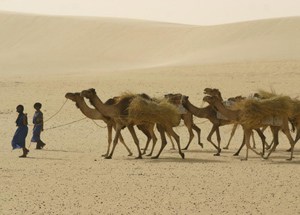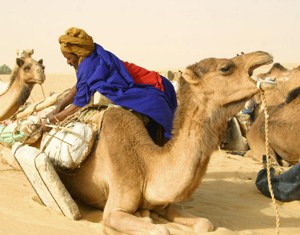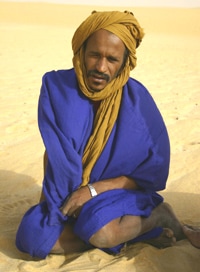By James Michael Dorsey

The blows sand and rocks our Land Rover as we reach the outskirts of Timbuktu, Mali.
Mahkmoud leans over the steering wheel and peers into the hazy lemon yellow that fills our windshield.
There is no horizon between earth and sky and I wonder how he can continue to drive with no reference points, yet on he goes with the instinct of a desert nomad. I realize for him, this is normal.
He tells me these storms can last for days but I do not care. I have finally reached one of the oldest and most remote cities on earth, so let it blow.
Coming to See the Taureg
I have come to see the Tuareg, The Blue Men of the Sahara, an ancient Berber tribe that ranges from southern Morocco, through Mauritania, south, here, into eastern Mali.
They are regal in their indigo turbans dyed from the ink of Mediterranean sea urchins and their flowing blue robes. Astride one of their white camels, they are a sight directly out of the “Arabian Nights.”
“No problem,” he says as he disappears into the night. An hour later he is back at the door, arms piled high with blue fabric.
“We will all travel as Tuaregs,” he says, “It will make things easier.’Later, at the hotel, in my hopes to enter their world for a brief time, I ask Halis, my Tuareg guide, if it might be possible to don the blue robes for a quick photo, hoping he will not take offense.
I do not know what this means until he points at the wall map. Tomorrow’s destination is his home village of Arawan, a former Foreign Legion outpost, north of Timbuctou in the trackless Sahara.
This is an area my guidebook calls “Bandit Country.” It is the only speck on the map for 120 miles in every direction.
I had not bargained for this but cannot pass the opportunity. Halis has shrugged off my query about bandits, saying they will not bother us. My own paranoia will have to decide if this is simply his own hubris or a statement of fact.
I am going into the deep desert not only with but dressed as a Berber nomad.
I awake early, tying and retying my turban in hopes of not making a fool of myself.

Just after dawn I walk through the hotel lobby feeling totally self-conscious but no one gives me a second look. I am just another Tuareg in search of morning coffee.
An hour later we are bouncing over loose sand, headed north, with 20 gallons of gas and four chickens on our roof. What have I done?
No Roads, Few Trees
There are no roads and few trees, only low scrub brush and moving dunes. Tuareg boys learn every star in the heavens and can easily navigate by them, but when I ask how he does this by day, Mahkmoud points to a tree and says, “That is where we ate spaghetti,” and at another saying, “That is where we camped with the Germans.”
He knows every natural formation like I know my living room, for this, is his.
We barrel along at thirty miles an hour, our wheels sometimes airborne, and Mahkmoud smiling like some demented Parnelli Jones. He is having a great time while I must blank my mind to the obvious fact that if we break down here it could be days before anyone finds us.
He and Halis frequently argue in French and I am later told this is over Mahkmoud’s choice of trails. Halis feels we are better off sticking to established tire tracks while Mahkmoud prefers to blaze his own way. All I can do is try not to think of broken axles.
At one point we crest an enormous dune and Mahkmoud tells me to get out and walk down in case he rolls the car. I am about to do so when I realize that would mean I am alone and on foot in the Sahara.
I refuse and tell him why. He laughs and with a loud throaty scream guns the engine sending us hurtling down a 100-foot wave of flowing sand, covering us in the process and forcing me to restart my heart.
Time and again, we “surf” the dunes and I finally learn to relax and trust his expert touch as we careen downhill at various weird angles.

Lighting a Fire
After four hours we stop under stunted mesquite and within seconds Mahkmoud has a fire going from broken branches after producing a spark with flint and adze while the wind howls around him.
In this weather, I could not produce a fire with a lighter and gasoline, but he has done it as his forefathers have for a thousand years. Minutes later we are sipping our hot sweet tea and eating tinned sardines.
I sit with my back to the wind marveling that Halis and Mahkmoud are comfortable in these conditions. When I stand up two minutes later, I leave a two-foot berm that has stacked up against my prone body.
After four more hours of trackless bouncing and sliding through loose sand we see the outlines of low squat buildings in the haze before us. The wind has never stopped blowing and we have reached Aroeoun.
I am anxious about our reception as I step into the maelstrom in my blue robes. I am instantly greeted by the outstretched hands of the village elder, Halis’ uncle, who takes me into a low adobe for more tea.
The building is pockmarked with bullet holes from a time when the Legion ruled this country with an iron fist. He tells me a visitor honors the Tuareg when they wear the robes, and I am the first outsider his nephew has brought to this village.
As I sip my tea, young men in indigo turbans file silently into the room to have a look at this strange westerner who would move among them.
A Communal Bowl of Beef
After greetings, a communal rice bowl appears with cubes of seared beef. The woman who serves it never lifts her eyes and exits the room quickly in one smooth motion. As an honored guest, I must eat first and am careful to follow Islamic tradition by scooping only with the fingers of my right hand.
I smack my lips loudly to show approval and quickly pass off the bowl to hungry faces lining the wall, knowing the children outside will only get to eat what I and the other men do not. As for the women, that is a world totally closed to me.
Halis calls me outside, yelling with excitement and pointing at a long black line on the horizon. A caravan is approaching and it appears to be a big one.

Running over the dunes is very slow going for the two miles to the well where the weary drivers will allow their beasts to stop.
Arriving with the first camels, their nomad handlers are startled to see a Tuareg wielding cameras, running in and out of their charges like a gleeful child.
I run between long lines of dromedary camels, (one hump) each carrying a handmade wooden rack on which is hung four tremendous blocks of salt weighing about 200 pounds a block.
Animal skins are slung between the blocks to act as buffers, and on top, numerous smaller slabs of salt are tied with rope to the carrying rack. The camels lumber on ignoring me as I dash through their ranks, beside myself in disbelief at this photographic opportunity.
Each camel is tethered to the tail of the one in front of him by a nose halter allowing one or two drivers to control more than 200 of them at a time. They move at a slow and steady gate, chewing their cuds as they lumber on.
Caravan Route
This strip of the southern Sahara has been a caravan route at least since the time of Jesus. The men and boys driving these camels were born to this as were their fathers and great, great grandfathers.
Halis will later tell me a Tuareg boy must make this trip at least once to be counted a man, and he himself has done it seven times.
Salt was once money in this part of the world and is still a valued commodity, so much so that those not willing to mine it are more than willing to take it at gunpoint.
Two of the drivers carry ancient muzzleloading rifles that would be more at home in a museum, yet out here may be the difference between life and death.
The camels are halted and their tenders begin the arduous task of unloading the heavy salt blocks. Each camel sits with its legs folded underneath waiting to have its burden temporarily lifted, protesting every human touch with the foulest sounding guttural noises. They are left untethered for they have nowhere to go and will not leave their food source.

Long sprouts of grain are spread on the sand for them to eat but they will get no water. Having just drunk three days prior, it would be a waste at this point.
Halis says the camels can go three weeks without water this time of year but when it gets hotter they must drink every week. When they do drink, they will consume 100 gallons of water in 10 minutes.
I marvel at these perfectly adapted creatures who carry unbelievable loads up to 40 miles a day. When they rest on the hot sand, hard callouses on their elbows and knees keep them from burning. Their nostrils lock shut during sand storms and their long lashes protect their eyes from blowing sand.
They store fat in their hump, not water as is commonly believed, and have extra thick lips to allow the ingestion of thorny desert plants.
When times are tough, they have been known to eat animal skin and bones and can digest almost anything. They are true, “ships of the desert” and one tries to bite me when I get too close, proving what I have heard about their nasty temperament.
Lost in a White Out
With the wind increasing, I fear becoming lost in a whiteout. I am almost two miles from Arawan and have limited vision. I tuck my cameras under my robes and put my head down into the wind, making for the nearest shelter before it is too late.
When I return the sun is setting and a small fire is burning between two buildings. Tea is on the brazier and the evening’s storytelling has already begun. I sit with my back to a wall and watch the firelight dance on the faces around me.
They are faces out of the Bible, ancient, weathered and wise. Tea is passed around and pipes are lit. Looking up at the stars I realize this scene would be no different if it took place a thousand years ago.
- Los Angeles: Zen and the City at Suiho En - October 5, 2017
- California: Culver City, Home of the Movies - September 4, 2017
- Tanzania: Barbaig Blacksmiths Create Beauty from Trash - April 11, 2017




Talk about gross white privilege. Cultural fetishism and appropriation galore. And accusing the suffering camels – clearly in terrible pain and forced to carry ‘unbelievable loads’ for their captors of having a ‘nasty temperament’ because they didn’t want him close to them?
No words.